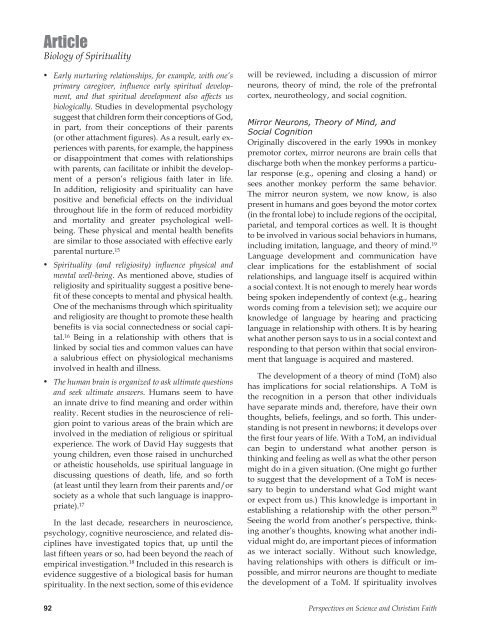ASA BLOGS - Start
ASA BLOGS - Start
ASA BLOGS - Start
Create successful ePaper yourself
Turn your PDF publications into a flip-book with our unique Google optimized e-Paper software.
Article<br />
Biology of Spirituality<br />
Early nurturing relationships, for example, with one’s<br />
primary caregiver, influence early spiritual development,<br />
and that spiritual development also affects us<br />
biologically. Studies in developmental psychology<br />
suggest that children form their conceptions of God,<br />
in part, from their conceptions of their parents<br />
(or other attachment figures). As a result, early experiences<br />
with parents, for example, the happiness<br />
or disappointment that comes with relationships<br />
with parents, can facilitate or inhibit the development<br />
of a person’s religious faith later in life.<br />
In addition, religiosity and spirituality can have<br />
positive and beneficial effects on the individual<br />
throughout life in the form of reduced morbidity<br />
and mortality and greater psychological wellbeing.<br />
These physical and mental health benefits<br />
are similar to those associated with effective early<br />
parental nurture. 15<br />
Spirituality (and religiosity) influence physical and<br />
mental well-being. As mentioned above, studies of<br />
religiosity and spirituality suggest a positive benefit<br />
of these concepts to mental and physical health.<br />
One of the mechanisms through which spirituality<br />
and religiosity are thought to promote these health<br />
benefits is via social connectedness or social capital.<br />
16 Being in a relationship with others that is<br />
linked by social ties and common values can have<br />
a salubrious effect on physiological mechanisms<br />
involved in health and illness.<br />
The human brain is organized to ask ultimate questions<br />
and seek ultimate answers. Humans seem to have<br />
an innate drive to find meaning and order within<br />
reality. Recent studies in the neuroscience of religion<br />
point to various areas of the brain which are<br />
involved in the mediation of religious or spiritual<br />
experience. The work of David Hay suggests that<br />
young children, even those raised in unchurched<br />
or atheistic households, use spiritual language in<br />
discussing questions of death, life, and so forth<br />
(at least until they learn from their parents and/or<br />
society as a whole that such language is inappropriate).<br />
17<br />
In the last decade, researchers in neuroscience,<br />
psychology, cognitive neuroscience, and related disciplines<br />
have investigated topics that, up until the<br />
last fifteen years or so, had been beyond the reach of<br />
empirical investigation. 18 Included in this research is<br />
evidence suggestive of a biological basis for human<br />
spirituality. In the next section, some of this evidence<br />
will be reviewed, including a discussion of mirror<br />
neurons, theory of mind, the role of the prefrontal<br />
cortex, neurotheology, and social cognition.<br />
Mirror Neurons, Theory of Mind, and<br />
Social Cognition<br />
Originally discovered in the early 1990s in monkey<br />
premotor cortex, mirror neurons are brain cells that<br />
discharge both when the monkey performs a particular<br />
response (e.g., opening and closing a hand) or<br />
sees another monkey perform the same behavior.<br />
The mirror neuron system, we now know, is also<br />
present in humans and goes beyond the motor cortex<br />
(in the frontal lobe) to include regions of the occipital,<br />
parietal, and temporal cortices as well. It is thought<br />
to be involved in various social behaviors in humans,<br />
including imitation, language, and theory of mind. 19<br />
Language development and communication have<br />
clear implications for the establishment of social<br />
relationships, and language itself is acquired within<br />
a social context. It is not enough to merely hear words<br />
being spoken independently of context (e.g., hearing<br />
words coming from a television set); we acquire our<br />
knowledge of language by hearing and practicing<br />
language in relationship with others. It is by hearing<br />
what another person says to us in a social context and<br />
responding to that person within that social environment<br />
that language is acquired and mastered.<br />
The development of a theory of mind (ToM) also<br />
has implications for social relationships. A ToM is<br />
the recognition in a person that other individuals<br />
have separate minds and, therefore, have their own<br />
thoughts, beliefs, feelings, and so forth. This understanding<br />
is not present in newborns; it develops over<br />
the first four years of life. With a ToM, an individual<br />
can begin to understand what another person is<br />
thinking and feeling as well as what the other person<br />
mightdoinagivensituation.(Onemightgofurther<br />
to suggest that the development of a ToM is necessarytobegintounderstandwhatGodmightwant<br />
or expect from us.) This knowledge is important in<br />
establishing a relationship with the other person. 20<br />
Seeing the world from another’s perspective, thinking<br />
another’s thoughts, knowing what another individual<br />
might do, are important pieces of information<br />
as we interact socially. Without such knowledge,<br />
having relationships with others is difficult or impossible,<br />
and mirror neurons are thought to mediate<br />
the development of a ToM. If spirituality involves<br />
92 Perspectives on Science and Christian Faith




